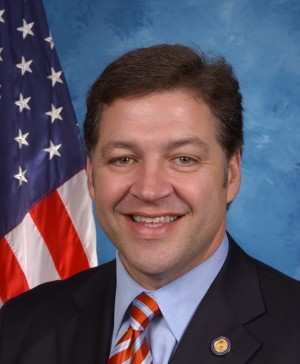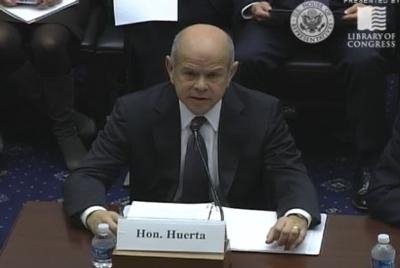Looking At The Implementation Of The Law Two Years In
The House Transportation Aviation Subcommittee held a hearing Wednesday to examine the ongoing implementation of the FAA Modernization and Reform Act, which Congress passed two years ago.

Committee Chairman Bill Shuster (R-PA) (pictured) cautioned in his opening statement that if the agency and congress are no proactive, the United States could lose its position as the global leader in aviation, "just as we’ve fallen behind in other important industries.
"Aviation is economically vital and essential to our global competitiveness," Shuster said during his opening remarks. "It means millions of American jobs and more than a trillion dollars for our economy.
"The Reform Act included important reforms to help strengthen our aviation system, and they must be implemented. We must also talk about how we are going to ensure a strong future for the system. We plan to sit down with interested stakeholders and listen to everyone’s ideas for the next reauthorization. We will take a close look at other aviation systems around the world to see what lessons we can learn from their successes and shortcomings."
Subcommittee Chair Frank LoBiondo (R-NJ) praised the FAA and administrator Michel Huerta for moving forward on UAS integration into the NAS. But "there are many other mandates included in the Reform Act – roughly 200 as the FAA likes to point out. In the nearly two years since the bill was enacted, the FAA has made progress in some areas, but remains challenged in others. Admittedly, not every provision or mandate is created equal, but it is still important to hear about the FAA’s progress in implementing the law."

LoBiondo (pictured) pointed out that the Reform Act made significant changes to the NextGen program, and that the FAA has made progress implementing some provisions, "but as the GAO and IG point out in their testimony, significant actions are needed to meet the intent of the Reform Act and improve the execution and management of NextGen," he said.
"I want to make clear to Administrator Huerta that I am closely monitoring the FAA’s response to the NextGen Advisory Committee’s priority recommendations," LoBiondo said. "This was not an exercise undertaken to validate the FAA’s NextGen implementation plan and it should not be treated as such by the FAA."
In his prepared remarks, Administrator Huerta said that he has filled two key positions to keep NextGen moving forward. "I named Michael G. Whitaker, who assumed the role of Deputy Administrator on June 3, 2013, Chief NextGen Officer. Mr. Whitaker is a seasoned aviation executive with extensive business, regulatory, legal, and international experience. I am confident that NextGen will continue to flourish under his leadership.
"Mr. Whitaker made it clear that helping to build and deploy NextGen was one of the principle reasons he joined the FAA and he has great commitment to ensuring that we reap the maximum benefits from NextGen enhancements.

"In September 2013, Air Force Major General Edward L. Bolton Jr. became the new Assistant Administrator for NextGen. Mr. Bolton’s accomplished military career involved many leadership positions. I am confident that he is well-suited to lead the talented workforce responsible for transforming the NAS under NextGen.
"NextGen is already delivering concrete benefits to users of the national airspace. Because of NextGen improvements, we are able to guide and track aircraft more precisely on more direct routes. This allows us to cut flight miles and reduce fuel burn, making air travel more convenient, predictable, and environmentally friendly. NextGen procedures have resulted in reductions in fuel consumption, carbon dioxide emissions, and noise, as envisioned at the time of the Reauthorization. We are projecting that NextGen will reduce overall delays by 41 percent by 2020, compared with what would happen if we did not implement any additional NextGen improvements."
Huerta also laid out his plans for integrating UAS technology into the National Air Space. "FAA estimates that we can expect 7,500 small unmanned aircraft in the NAS over the next five years, provided regulations and operational guidelines/policies are in place to handle them. We recognize that, while the expanded use of UAS presents great opportunities, integrating them also presents significant challenges. Operational issues, such as pilot training, must be addressed. Additionally, we need to make sure that unmanned aircraft can detect and avoid other aircraft and that they operate safely, even if they lose the link to the pilot in command. Likewise, manned aircraft must be able to detect these aircraft as well.
"Our airspace system is not static and it is important for industry to understand that unmanned operations will evolve over time, just as they have over the past decade. Today, unmanned aircraft are used to keep our borders safe. They help with scientific research and environmental monitoring. They support law enforcement agencies and help state universities conduct research.
"The UAS Comprehensive Plan was drafted by the Joint Planning and Development Office (JPDO) in coordination with JPDO Board participants from the Departments of Defense (DOD), Commerce (DOC), Homeland Security (DHS), the National Aeronautics and Space Administration (NASA) and the FAA. It is a document that considers UAS issues beyond 2015, including technologies necessary for safe and routine operation of civil UAS and the establishment of a process to inform FAA rulemaking projects related to certification, flight standards and air traffic requirements. The Comprehensive Plan details work that has been accomplished, along with future efforts needed to achieve safe integration of UAS into the NAS in the NextGen timeframe. It sets overarching, interagency goals, objectives, and approaches to achieving integration. Each partner agency will work to achieve these national goals and may develop agency-specific plans that are aligned to the national goals and objectives."
Other witnesses were Calvin Scovel, III, Inspector General, U.S. Department of Transportation, and Dr. Gerald Dillingham, Director – Civil Aviation Issues, Government Accountability Office.
 ANN's Daily Aero-Term (04.20.24): Light Gun
ANN's Daily Aero-Term (04.20.24): Light Gun Aero-News: Quote of the Day (04.20.24)
Aero-News: Quote of the Day (04.20.24) ANN's Daily Aero-Linx (04.21.24)
ANN's Daily Aero-Linx (04.21.24) Aero-News: Quote of the Day (04.21.24)
Aero-News: Quote of the Day (04.21.24) ANN's Daily Aero-Term (04.21.24): Aircraft Conflict
ANN's Daily Aero-Term (04.21.24): Aircraft Conflict





